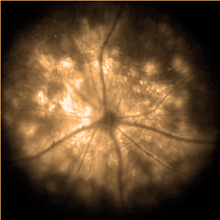Improving Gene Therapy for Eye Diseases
Improving Gene Therapy for Eye Diseases
Researchers developed a less invasive technique that delivers genes across the retinas of mouse and monkey eyes. With further development, the method might be used in people to treat inherited diseases that cause the retina to degenerate and impair sight.
The retina is the light-sensitive tissue at the back of the eye. It converts light into electrical impulses that are sent to the brain through the optic nerve, allowing us to see.

A fluorescent protein was produced across the mouse retina after its gene was delivered into the eye using a new technique. Image by the researchers, courtesy of Science Translational Medicine.
Certain inherited diseases, such as Leber congenital amaurosis (LCA), cause the retina to degenerate and lead to blindness. Scientists have made progress using gene therapy to treat these eye diseases, and several clinical trials are underway. However, the current therapies require inserting a needle through the retina and injecting the engineered virus behind the retina. The procedure can disrupt fragile diseased retinas and delivers the therapy to only a limited region.
A research team led by Drs. John G. Flannery and David V. Schaffer at the University of California, Berkeley, set out to develop an improved approach. The virus typically used for gene therapy in the eye is adeno-associated virus (AAV). This harmless virus can’t normally get through the layers of retinal cells to reach affected photoreceptor cells when injected into the vitreous humor—the more easily accessible gel-like fluid at the center of the eye. The scientists devised an approach to engineer variants of the virus that could get through the retina’s layers. They described their work, which was funded in part by NIH’s National Eye Institute (NEI) and the NIH Common Fund, on June 12, 2013, in Science Translational Medicine.
The researchers injected millions of genetically engineered variations of AAVs into the vitreous humor of transgenic mice and selected the variants that reached photoreceptor cells in the retina. After 3 rounds of selection, the scientists identified dozens of AAV variants capable of moving from the vitreous humor into the retina.
The most effective modified AAV, called 7m8, was used for further study. When injected into the vitreous humor of adult mice, 7m8 delivered genes throughout the retina and the optic nerve, but not into surrounding tissues outside of the eye. Using a more specific gene promoter restricted gene expression to photoreceptor cells.
The team tested 7m8 in mouse models of 2 inherited diseases in which mutated genes lead to retinal degeneration. In X-linked retinoschisis (XLRS), mutations in the gene encoding the retinoschisin protein cause splitting of the retina. LCA type 2 is caused by mutations in the RPE65gene. Injections of 7m8 carrying functional copies of these genes into the vitreous humor improved vision in both mouse models.
The new technique also successfully delivered genes across the retina of adult macaques. The team is now planning to perform additional research to prepare the 7m8 AAV for study in humans. They hope to soon head into early clinical trials.
“Building upon 14 years of research,” Schaffer says, “we have now created a virus that you can inject into the liquid vitreous humor inside the eye and it delivers genes to a very difficult-to-reach population of delicate cells in a way that is surgically much less invasive and safer.”
By Harrison Wein, Ph.D.
###
* The above story is reprinted from materials provided by National Institutes of Health (NIH)
** The National Institutes of Health (NIH) , a part of the U.S. Department of Health and Human Services, is the nation’s medical research agency—making important discoveries that improve health and save lives. The National Institutes of Health is made up of 27 different components called Institutes and Centers. Each has its own specific research agenda. All but three of these components receive their funding directly from Congress, and administrate their own budgets.



















